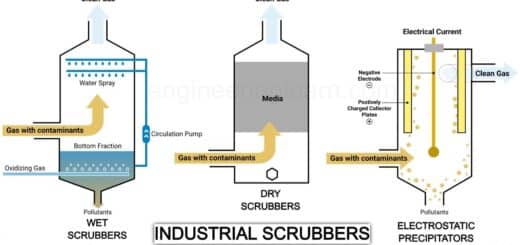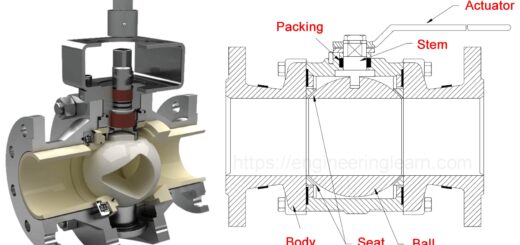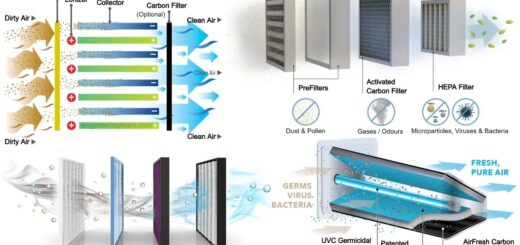17 Parts of AC (Air Conditioner) – With [Functions, Diagram Names & Pictures]
![17 Parts of AC (Air Conditioner) - With [Functions, Diagram Names & Pictures]](https://engineeringlearn.com/wp-content/uploads/2023/08/Parts-of-AC-1-1024x539.jpg)
Introduction
17 Parts of AC (Air Conditioner) – With [Functions, Diagram Names & Pictures]: – To Keep our climate and environment to our ideal temperature, the Air conditioning system is the gadget that assists us with accomplishing that. The system is common to such an extent that one can experience its effect or impact anyplace we enter. It tends to be installed in our homes, office, vehicles, and even at places where we visited for our daily routine like temples, washrooms, etc. To put it in a simple way, it tends to be utilized in both domestic and commercial environments.
Air conditioning is frequently referred to or alluded to as aircon, AC, or A/C. It includes and features a fan that disseminates or distributes the conditioned air to the encased space.
What is an AC (Air conditioner)?
Air conditioning system influences the room air to comfort individuals and their efficiency as well as productivity isn’t obstructed. An air conditioner is a system that is used to chill or cool down a space by removing or dispensing heat from the space and further moving it to some outer area. A process that is usually used to accomplish a more comfortable environment, fundamentally for humans and different animals. The quality of the air we inhale is unquestionably critical to our health, especially for those that experience the ill effects of allergies or respiratory conditions.
The air conditioning unit includes an evaporator coil, generally installed on top of the gas heater inside the home. It likewise uses a thermostat and a fan, which blows gas over chilled coils and into the room. The external unit contains the compressor, condenser, a few electrical parts, and another fan. Always Remember that for the air conditioner to enter into a room, an equivalent amount of air should have the option to leave the room. Any other way, there would be no space for the conditioned air to occupy.
Parts of AC (Air Conditioner)
Below we discuss different parts of Air conditioning and what are their functions: –
- Refrigerant
- Compressor
- Condenser Coil
- Evaporator Coil
- Thermostat
- Expansion Valve
- Thermistor
- Capacitor
- PCB
- Blower Motor
- Blower Fan
- Air Filter
- Aircon Vent
- Ductwork
- Damper
- Drain Pan
- Isolator Switch
1. Refrigerant: ( Parts of AC )
Refrigerant is found inside your air conditioner’s copper coils or curls. A refrigerant assists with the cooling function of your air conditioner, yet in addition a refrigerator, freezer, or whatever other appliance utilizes cooling. It operates on a closed loop and conveys heat from within your building to the outside. We use refrigerant since it changes states from liquid to vapor at accommodating temperatures for the refrigeration cycle.
In the event that you have a refrigerant leak happening in your house, you can simply call an expert to look at the issue and resolve it. Refrigerant leaks could appear to be a minor inconvenience on the grounds that, in many cases, you can in any case run your air conditioner in any event, while you’re experiencing this issue. One of the benefit of Refrigerant is that it is accessible free of cost, is non-toxic and non-combustible and doesn’t influence the commodity if unadulterated.
2. Compressor: ( Parts of AC )
The most essential as well as the significant part of all air conditioner parts, the compressor is the workhorse of air conditioning. If you utilize a home air conditioning unit, you’ve likely seen the compressor. An air conditioning compressor is a gadget that pumps refrigerant through the air conditioning system. It’s an essential part of an air conditioning system since it permits the heat pump to work. The compressor is within the inside part of the condenser unit, and it’s responsible for compressing refrigerant vapor.
When you turn your air conditioning unit on and hear a humming or murmuring sound, this is an indication that the compressor is working. On the off chance that no sound can be heard, it could actually mean that something is wrong with the system. Hence you can call an expert to resolve this issue.
3. Condenser Coil: ( Parts of AC )
The air conditioner coil is comprised of a few tubes filled or loaded up with refrigerant liquid. You can consider it something contrary to the evaporator coil. The condenser coil doesn’t work alone, regardless, works with the indoor evaporator coil to keep up and maintain the closed loop system.To deliver or convey cool air into the room in a proper way, the refrigerant fluid needs to rotate into its unique gaseous form, and the condenser coil passages divert the coolant into the evaporator coils in the indoor air conditioning system.
4. Evaporator Coil: ( Parts of AC )
An evaporator coil is also an essential part of an air conditioning system that eliminates heat from the air utilizing a refrigerant that goes through copper tubing. The evaporator coil is located close to the furnace, which circulates cool air into your home. Evaporators are parts of air conditioning tracked down inside the house close to the furnace. It’s connected or associated with the condenser with a very thin or slender line. The liquid is then converted completely to gas because of the decreasing pressure. The fluid or refrigerant removes the heat and cools it off. The evaporator releases the fluid as a gas to get compressed again by the compressor. These all happen in a cyclic fashion.
Evaporator coils are vital to an air conditioner. It’s where the air conditioner really gets the heat from inside your home. Keeping and maintaining your evaporator coil clean is essential to keeping up with the efficiency of your system. Dirty coils can increase or expand the energy utilization of your AC unit by up to 30 percent. Poorly maintained coils can likewise lead to different issues with the system, for example, poor cooling performance because of reduced heat transfer, frozen coils, and an overheating compressor. You can keep your evaporator coils clean and assist them with performing better by changing your air filter not less than one time per month. At the point when your filter turns out to be excessively clogged, the dirt and dust will start to settle on the evaporator coils rather than the air filter.
5. Thermostat: ( Parts of AC )
In a heating and cooling system, the temperature is set utilizing the thermostat, which works by signaling the unit to produce the ideal temperature in the room..contingent upon the design, a thermostat can be set manually or automatically. This is where you inform your AC unit regarding your cooling preferences, and it likewise switches the air conditioner on or off to maintain the best indoor temperature. With in-built temperature and humidity sensors, it can undoubtedly read your room’s temperature.
With a programmable or savvy thermostat, you have some control over your AC temperature from your phone and set commands like schedules or geofencing. Assuming that you have a ducted AC, for example, a mini-split or window unit, you can utilize a smart AC controller that works very much like a thermostat for central systems.
6. Expansion Valve: ( Parts of AC )
The expansion valve is one of the most critical parts of an air conditioning system. The expansion valve permits one minute amount of liquid refrigerant to flow into the coils all at once, permitting the liquid to expand in a vapor form, causing a huge drop in temperature. Expansion valves don’t directly influence the temperature in the room, yet they truly do function to move refrigerant into the evaporator, which provides the cooling effect.
The expansion valve doesn’t directly cool refrigerant. Rather, it in an indirect way cools refrigerant by eliminating excess pressure from it. Assuming that the expansion valve fails, eliminating pressure from the refrigerant will not be possible.
7. Thermistor: ( Parts of AC )
A thermistor is a temperature sensor that is found in most present-day air conditioning systems that direct and control the temperatures of your room. The thermostat detects room temperature and sends back resistance signals, which automatically adjust or change the room’s control system for further improved comfort.
8. Capacitor: ( Parts of AC )
The capacitor starts the different air conditioner motors and keeps them along by building up a store of electricity that can be utilized to provide nonstop power. The point when someone switches or turns their AC on, it conveys the electric boost needed to turn the unit and provide constant power.
9. PCB: ( Parts of AC )
An air conditioner PCB is the motherboard of an air conditioner unit. These gadgets are like a computer ‘motherboard’ or central processor unit, yet it likewise serves as a wiring for different parts like resistors, capacitors, and transistors. The connections or associations between these various parts are known as conductive tracks, which connect or interface all important wires with copper layers on fiberglass silk screening.
10. Blower Motor: ( Parts of AC )
The blower motor on an air conditioner unit is there to make the fan blades move, which moves air through the system. It is one of the fundamental parts for the air conditioning system to work in a proper way. The blower motor turns on the fan in your air conditioning system, allowing the air to circulate or flow out of the system and into the rooms of your home.
11. Blower Fan: ( Parts of AC )
The blower fan is one of the critical parts of any air conditioning system. It blows cool and fresh air into your home, which creates a cooling effect and impact that leaves you feeling refreshed subsequent to being exposed to its chilly breeze for a really long time.
12. Air Filter: ( Parts of AC )
An air conditioner filter utilizes a permeable structure that prevents large and coarse particles from passing through. Its purpose is to remove or eliminate pollutants, similar to dust, oil, residue or smoke, and so on, to improve the indoor climate’s quality by preventing or forestalling a wide range of allergens and foreign substances from infiltrating your home.
13. Aircon Vent: ( Parts of AC )
Air conditioning vents are there to assist with keeping the air pressure in your home or office at a comfortable level. You may not realize it, yet these openings likewise serve an additional function, they filter out any dust or residue that could have advanced into your home.
14. Ductwork: ( Parts of AC )
Ducts, also called duck-work, are a progression of flexible metal tubes that transport temperature-treated air from your HAVC system to your home. Ductwork snakes through your basement, attic, and, surprisingly, inside your walls to reach the vents you see dispersed or scattered all through your home.
15. Damper: ( Parts of AC )
HAVC air dampers, or duct dampers, are movable or portable plates found in the ductwork of a home’s heating and cooling system. You can open as well as close them to control how much airflow coming through the ducts. Dampers assist you with avoiding overheating or over-cooling certain rooms, giving you more choices to control your family’s solace and enhance energy utilization.
16. Drain Pan: ( Parts of AC )
Inside the air conditioning system is a drain pan that catches the condensation that falls off the condenser coils. The water then drains through pipes to be dumped out or discharged or released outside, contingent upon its location. The primary purpose of a drain pan in an air conditioning system is to prevent water from leaking all over the place.
17. Isolator Switch: ( Parts of AC )
Air conditioning isolator switches are gadgets or systems that isolate or segregate a specific circuit for maintenance. Prevents currents from passing through, they’re utilized to ensure the safety of engineers performing repairs and improvements on circuits.
Conclusion
Air conditioning is frequently referred or alluded to as aircon, AC, or A/C. It features or includes a fan that disperses the condensed air to the encased space. The air conditioning system is a vital and imperative piece of any home or building. It’s essential to understand the various parts and how they work together to maintain your system for a really long time of use. We’ve illustrated a portion of these parts above. You should look more about aircon power utilization and how to utilize different aircon modes to save energy. When all is functioning as you desired, you don’t for even a moment notice that there are numerous parts inside the box, making up your air conditioning system work without a hitch.













